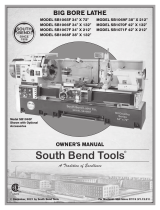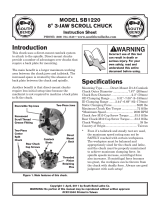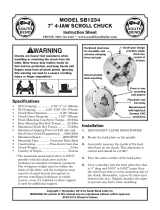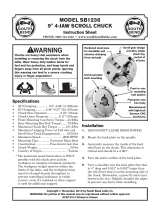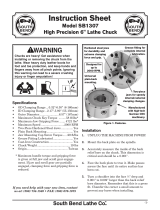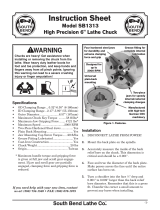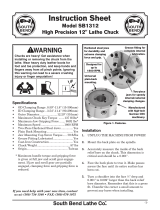Page is loading ...

© June, 2011 by South Bend Lathe Co. For Machines Mfg. Since 3/11
16 SPEED GEARHEAD LATHE
MODEL SB1053 14" X 40"
MODEL SB1054F 16" X 40" w/DRO
MODEL SB1055F 16" X 60" w/DRO
OWNER'S MANUAL

Customer Service
We stand behind our machines. If you have any service questions, parts requests or general questions
about your purchase, feel free to contact us.
South Bend Lathe Co.
P.O. Box 2027
Bellingham, WA 98227
Phone: (360) 734-1540
Fax: (360) 676-1075 (International)
Fax: (360) 734-1639 (USA Only)
Email: [email protected]
Updates
For your convenience, any updates to this manual will be available to download free of charge
through our website at:
www.southbendlathe.com
Scope of Manual
This manual helps the reader understand the machine, how to prepare it for operation, how to control
it during operation, and how to keep it in good working condition. We assume the reader has a basic
understanding of how to operate this type of machine, but that the reader is not familiar with the
controls and adjustments of this specific model. As with all machinery of this nature, learning the
nuances of operation is a process that happens through training and experience. If you are not an
experienced operator of this type of machinery, read through this entire manual, then learn more
from an experienced operator, schooling, or research before attempting operations. Following this
advice will help you avoid serious personal injury and get the best results from your work.
Manual Feedback
We've made every effort to be accurate when documenting this machine. However, errors sometimes
happen or the machine design changes after the documentation process—so
the manual may not
exactly match your machine.
If a difference between the manual and machine leaves you in doubt,
contact our
customer service for clarification.
We highly value customer feedback on our manuals. If you have a moment, please share your
experience using this manual. What did you like about it? Is there anything you would change to
make it better? Did it meet your expectations for clarity, professionalism, and ease-of-use?
South Bend Lathe, Inc.
C
/O Technical Documentation Manager

Table of Contents
INTRODUCTION ....................................................3
About This Machine .............................................3
Foreword ............................................................. 3
Capabilities .........................................................3
Features ..............................................................3
General Identification ..........................................4
Controls & Components.......................................5
Master Power Switch ........................................... 5
Two-Speed Motor Switch......................................5
Spindle Speed Levers & Chart .............................5
Feed Controls ......................................................6
Control Panel ......................................................6
Quick-Change Gearbox Controls ..........................6
Carriage Controls ................................................7
Tailstock Controls ................................................8
Foot Brake ..........................................................8
SB1053 Machine Specifications ..........................9
SB1054F Machine Specifications ........................ 9
SB1055F Machine Specifications ........................ 9
SAFETY ................................................................13
Understanding Risks of Machinery ..................13
Basic Machine Safety ........................................13
Additional Metal Lathe Safety ..........................15
Chuck Safety ......................................................16
PREPARATION ....................................................17
Preparation Overview ........................................17
Things You'll Need .............................................17
Power Supply Requirements ............................. 18
Availability ........................................................18
Full-Load Current Rating ..................................18
Circuit Requirements .........................................18
Grounding Requirements ...................................19
Unpacking ..........................................................20
Inventory ............................................................20
Cleaning & Protecting .......................................21
Location ..............................................................22
Physical Environment ........................................22
Electrical Installation ........................................22
Lighting ............................................................22
Weight Load ...................................................... 22
Space Allocation ................................................22
Lifting & Moving ................................................23
Leveling & Mounting .........................................24
Leveling ............................................................24
Bolting to Concrete Floors ..................................25
Assembly ............................................................25
Lubricating Lathe .............................................. 25
Adding Coolant ..................................................26
Power Connection ..............................................26
Test Run .............................................................28
Spindle Break-In ................................................32
Recommended Adjustments .............................. 32
OPERATION ........................................................33
Operation Overview ...........................................33
Chuck & Faceplate Mounting ...........................34
Installation & Removal Devices ........................34
Chuck Installation .............................................35
Registration Marks ............................................36
Chuck Removal ..................................................36
Scroll Chuck Clamping ......................................37
4-Jaw Chuck .......................................................37
Mounting Workpiece ..........................................37
Faceplate ............................................................38
Tailstock .............................................................39
Positioning Tailstock .........................................39
Using Quill ........................................................39
Installing Tooling ..............................................40
Removing Tooling ..............................................41
Offsetting Tailstock ...........................................41
Aligning Tailstock to Spindle Centerline ............42
Centers ...............................................................43
Dead Centers .....................................................43
Live Centers ...................................................... 44
Mounting Dead Center in Spindle ......................44
Removing Center from Spindle ...........................44
Mounting Center in Tailstock .............................44
Removing Center from Tailstock ........................45
Mounting Workpiece Between Centers ............... 45
Steady Rest ........................................................46
Follow Rest .........................................................47
Carriage & Compound Rest Locks ....................47
Compound Rest .................................................. 48
Four-Way Tool Post ...........................................48
Installing Tool ...................................................48
Aligning Cutting Tool with Spindle Centerline ...49
Adjustable Feed Stop .........................................50
Micrometer Stop.................................................50
Manual Feed ......................................................51
Carriage Handwheel ..........................................51
Cross Slide Handwheel ......................................51

Compound Rest Handwheel ...............................51
Spindle Speed .....................................................51
Determining Spindle Speed ................................51
Setting Spindle Speed ........................................52
Configuration Examples .....................................52
Power Feed ......................................................... 53
Power Feed Controls ..........................................54
Setting Feed Rate ..............................................55
End Gears ...........................................................56
Standard End Gear Configuration ......................56
Alternate Configuration ..................................... 57
Threading Controls ............................................58
Setting Threading Controls ................................58
Apron Controls ..................................................59
Thread Dial ....................................................... 59
Thread Dial Chart .............................................60
Chip Drawer .......................................................61
Coolant System ..................................................62
ACCESSORIES ...................................................63
Accessories .........................................................63
MAINTENANCE ...................................................65
Maintenance Schedule .......................................65
Cleaning & Protecting .......................................65
Maintenance Chart ............................................66
Lubrication ......................................................... 67
Headstock .........................................................67
Quick-Change Gearbox ......................................68
Apron ................................................................ 68
One-Shot Oiler ..................................................69
Leadscrew .........................................................70
Ball Oilers & Oil Cup .........................................70
End Gears .........................................................71
Coolant System Service .....................................72
Hazards.............................................................72
Adding Fluid .....................................................73
Changing Coolant .............................................. 73
Machine Storage ................................................74
Backlash Adjustment ........................................75
Compound Rest .................................................75
Cross Slide ........................................................76
Leadscrew End Play Adjustment ......................76
SERVICE .............................................................. 77
Gib Adjustment ..................................................77
Half Nut Adjustment ......................................... 78
Feed Rod Clutch Adjustment ............................79
V-Belts ................................................................ 80
Brake & Switch .................................................. 81
Leadscrew Shear Pin Replacement ..................82
Gap Insert Removal & Installation ..................85
Gap Removal ..................................................... 85
Gap Installation ................................................85
TROUBLESHOOTING ......................................... 86
ELECTRICAL ........................................................89
Electrical Safety Instructions ...........................89
Correcting Phase Polarity Wiring .....................90
Wiring Overview ................................................91
Component Location Index................................92
Electrical Box Wiring.........................................93
Electrical Box .....................................................94
Spindle Motor .....................................................95
Coolant Pump Wiring ........................................95
2-Speed Motor Switch ........................................96
Control Panel Wiring .........................................97
Spindle ON/OFF Switches.................................97
Power Connection ..............................................98
Additional Component Wiring ..........................98
PARTS ..................................................................99
Headstock ........................................................... 99
Gearbox ............................................................105
Apron ................................................................109
End Gears .........................................................112
Spindle Motor Assembly ..................................113
Saddle & Cross Slide .......................................115
Compound Slide & Tool Post ...........................118
Bed & Shafts ....................................................119
Cabinet Stands & Panels.................................121
Tailstock ...........................................................124
Thread Dial ......................................................126
Micrometer Stop...............................................126
Steady Rest ......................................................127
Follow Rest .......................................................127
Electrical ..........................................................128
Accessories .......................................................129
Front Machine Labels ......................................130
Rear & Side Machine Labels ...........................131
WARRANTY .......................................................132

For Machines Mfg. Since 3/11 16-Speed Gearhead Lathe
-3-
INTRODUCTION
About This Machine
Foreword
"The screw cutting engine lathe is the oldest and
most important of machine tools and from it all
other machine tools have been developed. It was
the lathe that made possible the building of the
steamboat, the locomotive, the electric motor, the
automobile and all kinds of machinery used in
industry. Without the lathe our great industrial
progress of the last century would have been
impossible." —How To Run a Lathe, 15th
Edition, South Bend Lathe.
The lathe represented in this manual is a
modern day version of the screw cutting lathes
that trace their roots back to the 1700's, which
were themselves technological improvements of
the bow lathe that can be traced back thousands
of years to the ancient Egyptians.
Now, almost 300 years later, these modern
"screw cutting" lathes are not just a piece of
refined machinery, but a culmination of human
ingenuity and knowledge embodied into the
design and synergy of thousands of interworking
parts—some of which represent the life's work
and dreams of many inventors, mechanical
engineers, and world-class machinists—including
the likes of Leonardo da Vinci, Henry Maudsley,
and the founders of South Bend Lathe, John and
Miles O'Brien.
And now the torch is passed to you—to take
the oldest and most important type of machine
tool—and carry on the tradition. As the operator
of a South Bend Lathe, you now join the ranks
of some very famous and important customers,
such as Henry Ford, who used the machines he
purchased to help him change the world.
Features
This 16-Speed Gearhead Lathe is packed with
standard features and equipment, such as a
complete coolant system, easy-to-clean chip
drawer, one-shot way lubrication system,
included steady and follow rests, chuck guard,
adjustable work lamp, foot brake, powered cross
feed, 3- and 4-jaw chucks, and faceplate. Models
SB1054F and SB1055F also feature a Fagor
2-axis 20iT DRO.
Spindle speeds are controlled by a 2-speed motor
and convenient headstock levers, which allow the
operator to quickly set the spindle speed within
the available range of 40–2000 RPM.
Bed ways are constructed with Meehanite
castings that are precision hardened and ground
in the traditional 3-V prismatic design—long
used on South Bend Lathes for accuracy,
durability, and rigidity.
Headstock features quick-change gear controls
and an adjustable clutch mechanism that can
be set to disable the feed rod to prevent crash
damage. Spindle is a D1-6 (camlock type) with an
MT#6 taper and 2
1
⁄16" bore. Tailstock quill has an
MT#4 taper and offers 6" of travel.
Finally, to ensure long-lasting accuracy in the
most demanding shops, the spindle is equipped
with Japanese NTN bearings.
Capabilities
This 16-Speed Toolroom Lathe is built for daily
use in a busy industrial setting. Loaded with
many nice features and high-precision parts, this
lathe excels at making fine tools, dies, thread
gauges, jigs, and precision test gauges—however,
it is by no means delicate. Thick castings, heavy
weight, and quality construction throughout
provide the necessary brawn for demanding
production and manufacturing tasks.
16" South Bend Precision Toolroom Lathe
(Circa 1958)

-4-
For Machines Mfg. Since 3/11
16-Speed Gearhead Lathe
INTRODUCTION
General Identification
K. Tailstock
L. Longitudinal Leadscrew
M. Feed Rod
N. Coolant Tank & Pump Access
O. Carriage
P. Brake Pedal
Q. Chip Drawer
R. Micrometer Stop
S. Spindle Motor 2-Speed Switch
T. Quick-Change Gearbox Controls
U. Headstock Controls
A. Headstock
B. D1-6 Camlock MT#6 Spindle
C. Chuck Guard w/Safety Switch
D. Steady Rest
E. Follow Rest
F. Halogen Work Lamp
G. 4-Way Tool Post
H. Fagor 2-Axis DRO (SB1054F & SB1055F
only)
I. Compound Rest
J. Coolant Nozzle & Valve
Serious personal injury could occur if
you connect the machine to power before
completing the setup process. DO NOT
connect power until instructed to do so later
in this manual.
Untrained users have an increased risk
of seriously injuring themselves with this
machine. Do not operate this machine until
you have understood this entire manual and
received proper training.
Figure 1. General identification (Model SB1054F shown).
D
E
C
B
F
G
I
J
K
N
O
Q
P
S
T
U
L
M
R
H
A

For Machines Mfg. Since 3/11 16-Speed Gearhead Lathe
-5-
INTRODUCTION
Refer to Figures 2–9 and the following
descriptions to become familiar with the features
and basic controls of this lathe. This knowledge
will be necessary to properly set up the lathe for
the test run and spindle break-in.
Controls &
Components
Figure 2. Location of the master power switch.
Main Power
Switch
Two-Speed Motor Switch
One of three controls used to select spindle
speed. Select LOW or HIGH motor speeds,
which represent the top or bottom row of
speed available on the spindle speed chart (see
Figure 4).
Master Power Switch
The master power switch enables power to all
lathe electrical controls.
To reduce the risk of
serious injury when using
this machine, read and
understand this entire
manual before beginning any
lathe operations.
Spindle Speed Levers & Chart
Figure 4. Spindle speed chart.
C
B
A
D
10006253752451651006040
2000125075049033020012080
DCBADCBA
Spindle
Speed
Lever
Spindle
Range
Lever
Speed
Chart
Spindle Speed Lever: One of three controls used
to select spindle speed. Selects A, B, C, or D gear
position on the spindle speed chart.
Spindle Range Lever: One of three controls used
to select spindle speed. Selects low or high range
of spindle speeds on the spindle speed chart (low
range is on the left, high range is on the right).
Spindle Speed Chart: Displays the position of the
two-speed motor switch, spindle speed lever, and
spindle range lever required to achieve each of
the 16 available spindle speeds.
Figure 3. Location of two-speed motor switch.
Two-Speed
Motor Switch
LOW HIGH
OFF

-6-
For Machines Mfg. Since 3/11
16-Speed Gearhead Lathe
INTRODUCTION
Feed Controls
Feed Range Lever: Shifts the quick-change
gearbox into low range, neutral, or high range.
Feed Direction Lever: Controls the direction of
the leadscrew or feed rod.
Control Panel
Coolant Switch: Starts and stops the coolant
pump. Fluid flow is controlled by the valve on the
coolant nozzle.
Power Light: Illuminates when power is enabled
to all lathe electrical controls.
STOP Button: Cuts power to the spindle motor
and coolant pump.
Jog Button: Turns spindle motor ON when being
pressed.
Quick-Change Gearbox Controls
Figure 7. Quick-change controls.
Feed Rate
& Threading Charts
Quick-Change
Controls
Quick-Change Gearbox Controls: Set the quick-
change gearbox configuration for feeding and
threading operations.
Figure 5. Feed controls on headstock.
Feed Range Lever
Feed Direction Lever
Figure 6. Control panel.
Coolant
Switch
Power
Light
STOP
Button
Jog
Button

For Machines Mfg. Since 3/11 16-Speed Gearhead Lathe
-7-
INTRODUCTION
A. 4-Position Tool Post Lever: Locks the tool
holder in four possible positions.
B. Compound Rest Handwheel: Moves the
cutting tool back and forth relative to
the workpiece. Includes an indirect-read
graduated dial, which represents actual tool
movement.
C. Coolant Valve Lever: Controls the flow of
coolant from the nozzle.
D. One-Shot Oiler: Draws oil from the apron
reservoir and lubricates the bed ways
underneath the saddle.
E. Carriage Lock Bolt: Secures the carriage in
place for greater rigidity and accuracy when
using the cross slide or compound rest for
machining operations.
Figure 8. Carriage controls.
A
C
B
E
D
F
G
I
J
K
L
N
M
H
F. Thread Dial: Indicates when to engage the
half nut during inch threading operations.
G. Spindle ON/OFF Lever: Starts, stops and
reverses direction of spindle rotation.
H. Thread Dial Chart: For each inch thread,
displays which number on the thread dial to
engage the half nut.
I. Half Nut Lever: Engages and disengages the
half nut for threading operations.
J. Quick-Change Feed Direction Knob: Changes
direction of carriage feed or the cross slide
feed without having to stop the lathe and
move the headstock feed direction lever.
K. Feed Control Lever: Engages and disengages
the cross slide or carriage feed.
L. Carriage Handwheel: Moves the carriage
manually along the bed.
M. Apron: Houses the carriage gearing and
controls.
N. Cross Slide Handwheel: Moves the cross
slide toward or away from the workpiece.
Includes a direct-read graduated dial, which
represents half the amount of tool movement
and the total amount of material removed
from the diameter of the workpiece.
Carriage Controls

-8-
For Machines Mfg. Since 3/11
16-Speed Gearhead Lathe
INTRODUCTION
Foot Brake
This lathe is equipped with a foot brake (see
Figure 10) to quickly stop the spindle instead of
allowing it to coast to a stop on its own. Pushing
the foot brake while the spindle is ON also cuts
power to the motor.
After the foot brake is used, the spindle ON/
OFF lever must be returned to the OFF (middle)
position to reset the spindle switches, which will
enable spindle rotation.
Figure 10. Foot brake and spindle ON/OFF lever.
Foot Brake
Spindle
ON/OFF Lever
Tailstock Controls
Figure 9. Tailstock controls.
A
F
G
B
C
D
E
H
A. Tailstock Handwheel: Moves the quill toward
or away from the spindle.
B. Graduated Scale: Indicates quill movement
in increments of 0.001". One full rotation of
handwheel is 0.100".
C. Tailstock Lock Lever: Secures the tailstock in
place along the bedway.
D. Quill Lock Lever: Locks the quill in position.
E. Quill: Holds centers or tooling with an MT#4
taper. Moves toward and away from the
spindle.
F. Tailstock Offset Screw: Adjusts and secures
the tailstock offset (1 of 2).
G. Gib Adjustment Screw: Adjusts the tailstock
gib that controls side-to-side movement (1 of
2).
H. Offset Scale: Indicates the distance of
tailstock offset from the spindle centerline.
The scale increments are arbitrary.

For Machines Mfg. Since 3/11 16-Speed Gearhead Lathe
-9-
INTRODUCTION
MODEL SB1053, SB1054F, SB1055F
16 SPEED GEARHEAD LATHES
P.O. Box 2027, Bellingham, WA 98227 U.S.A.
PHONE: (360) 734-1540 • © South Bend Lathe Co.
www.southbendlathe.com
Product Specifications
Model Number SB1053 SB1054F SB1055F
Product Dimensions
Weight 2970 lbs. 3080 lbs. 3300 lbs.
Width (side-to-side)/Depth
(front-to-back)/Height
86 x 32-3/4 x 48 in. 86 x 32-3/4 x 49 in. 105-1/2 x 32-3/4 x 49 in.
Foot Print (Width/Depth) 82 x 19-1/2 in. 82 x 19-1/2 in. 102 x 19-1/2 in.
Shipping Dimensions
Type Wood Slat Crate Wood Slat Crate Wood Slat Crate
Weight 3234 lbs. 3344 lbs. 3652 lbs.
Width (side-to-side)/Depth
(front-to-back)/Height
94 x 44 x 69 in. 94 x 45 x 69 in. 109 x 45 x 69 in.
Electrical
Power Requirement 220V, 3-Phase, 60 Hz 440V, 3-Phase, 60 Hz 440V, 3-Phase, 60 Hz
Full-Load Current Rating
18.3A at 850 RPM,
20.15A at 1725 RPM
10.15A 10.23A
Minimum Circuit Size 30A 15A 15A
Switch
Magnetic with Thermal
Protection
Magnetic with Thermal
Protection
Magnetic with Thermal
Protection
Switch Voltage 220V 440V 440V
Plug Included No No No
Recommended Plug/Outlet Type NEMA L15-30
Hardwire to Locking
Disconnect Switch
Hardwire to Locking
Disconnect Switch

-10-
For Machines Mfg. Since 3/11
16-Speed Gearhead Lathe
INTRODUCTION
Model Number SB1053 SB1054F SB1055F
Main Motor
Type TEFC Induction TEFC Induction TEFC Induction
Horsepower 7.5 HP 7.5 HP 7.5 HP
Voltage 220V 440V 440V
Phase 3-Phase 3-Phase 3-Phase
Amps
18A at 850 RPM, 20A at
1725 RPM
10A at 1725 RPM, 9A at
850 RPM
10A at 1725 RPM, 9A at
850 RPM
Speed 850/1725 RPM 1720/850 RPM 1720/850 RPM
Cycle 60 Hz 60 Hz 60 Hz
Power Transfer V-Belt & Gear V-Belt & Gear V-Belt & Gear
Bearings
Shielded & Permanently
Sealed
Shielded & Permanently
Sealed
Shielded & Permanently
Sealed
Coolant Motor
Type TEFC Induction TEFC Induction TEFC Induction
Horsepower 1/8 HP 1/8 HP 1/8 HP
Voltage 220V 440V 440V
Phase 3-Phase 3-Phase 3-Phase
Amps 0.3A 0.15A 0.23A
Speed 3450 RPM 3450 RPM 3450 RPM
Cycle 60 Hz 60 Hz 60 Hz
Power Transfer Direct Drive Direct Drive Direct Drive
Bearings
Shielded & Permanently
Sealed
Shielded & Permanently
Sealed
Shielded & Permanently
Sealed
Operation Information
Swing Over Bed 14.17 in. 16-1/8 in. 16-1/8 in.
Distance Between Centers 40 in. 40 in. 60 in.
Swing Over Cross Slide 8.42 in. 10.375 in. 10.375 in.
Swing Over Saddle 13.75 in. 15.75 in. 15.75 in.
Swing Over Gap 20.98 in. 22.95 in. 22.95 in.
Maximum Tool Bit Size 3/4 in. 3/4 in. 3/4 in.
Compound Travel 5.12 in. 5.1 in. 5.1 in.
Carriage Travel 38.58 in. 38.58 in. 54 in.
Cross Slide Travel 9 in. 9 in. 9 in.

For Machines Mfg. Since 3/11 16-Speed Gearhead Lathe
-11-
INTRODUCTION
Model Number SB1053 SB1054F SB1055F
Headstock Information
Spindle Bore 2.06 in. 2-1/16 in. 2-1/16 in.
Spindle Taper MT#6 MT#6 MT#6
Number of Spindle Speeds 16 16 16
Range of Spindle Speeds 40 – 2000 RPM 40 – 2000 RPM 40 – 2000 RPM
Spindle Type D1-6 Camlock D1-6 Camlock D1-6 Camlock
Spindle Bearings NTN Tapered Roller NTN Tapered Roller NTN Tapered Roller
Tailstock Information
Tailstock Quill Travel 6 in. 6 in. 6 in.
Tailstock Taper MT#4 MT#4 MT#4
Tailstock Barrel Diameter 2.047 in. 2.047 in. 2.047 in.
Threading Information
Number of Longitudinal Feeds 17 17 17
Range of Longitudinal Feeds 0.002 – 0.067 in./rev. 0.002 – 0.067 in./rev. 0.002 – 0.067 in./rev.
Number of Cross Feeds 17 17 17
Range of Cross Feeds 0.001 – 0.034 in./rev. 0.001 – 0.034 in./rev. 0.001 – 0.034 in./rev.
Number of Inch Threads 45 45 45
Range of Inch Threads 2 – 72 TPI 2 – 72 TPI 2 – 72 TPI
Number of Metric Threads 39 39 39
Range of Metric Threads 0.2 – 14 mm 0.2 – 14 mm 0.2 – 14 mm
Number of Modular Pitches 18 18 18
Range of Modular Pitches 0.3 – 3.5 MP 0.3 – 3.5 MP 0.3 – 3.5 MP
Number of Diametral Pitches 21 21 21
Range of Diametral Pitches 8 – 44 DP 8 – 44 DP 8 – 44 DP
Dimensions
Bed Width 10-1/4 in. 10-1/4 in. 10-1/4 in.
Leadscrew Diameter 1-1/8 in. 1-1/8 in. 1-1/8 in.
Leadscrew TPI 4 TPI 4 TPI 4 TPI
Leadscrew Length 63.58 in. 63.58 in. 83.58 in.
Steady Rest Capacity 5/16 – 4-5/16 in. 5/16 – 4-5/16 in. 5/16 – 4-5/16 in.
Follow Rest Capacity 5/8 – 3-1/8 in. 5/8 – 3-1/8 in. 5/8 – 3-1/8 in.
Faceplate Size 12 in. 12 in. 12 in.
Feed Rod Diameter 3/4 in. 3/4 in. 3/4 in.
Floor to Center Height 42 in. 43-1/2 in. 43-1/2 in.
Height With Leveling Jacks 43-1/2 in. 44-1/2 in. 44-1/2 in.

-12-
For Machines Mfg. Since 3/11
16-Speed Gearhead Lathe
INTRODUCTION
Model Number SB1053 SB1054F SB1055F
Construction
Headstock Cast Iron Cast Iron Cast Iron
Headstock Gears Flame-Hardened Steel Flame-Hardened Steel Flame-Hardened Steel
Bed
Meehanite Castings with
Induction-Hardened Ways
Induction-Hardened Ways Induction-Hardened Ways
Stand Cast Iron Cast Iron Cast Iron
Paint Urethane Urethane Urethane
Other
Country of Origin
Taiwan (Some
Components Made in
USA & Japan)
Taiwan (Some
Components Made in
USA & Japan)
Taiwan (Some
Components Made in
USA & Japan)
Warranty 1 Year 1 Year 1 Year
Serial Number Location
ID Label on Rear Side of
Left Stand
ID Label on Rear Side of
Left Stand
ID Label on Rear Side of
Left Stand
Assembly Time Approximately 1 Hour Approximately 1 Hour Approximately 1 Hour

SAFETY
For Machines Mfg. Since 3/11 16-Speed Gearhead Lathe
-13-
SAFETY
Understanding Risks of Machinery
Operating all machinery and machining equipment can be dangerous or relatively safe depending
on how it is installed and maintained, and the operator's experience, common sense, risk awareness,
working conditions, and use of personal protective equipment (safety glasses, respirators, etc.).
The owner of this machinery or equipment is ultimately responsible for its safe use. This
responsibility includes proper installation in a safe environment, personnel training and usage
authorization, regular inspection and maintenance, manual availability and comprehension,
application of safety devices, integrity of cutting tools or accessories, and the usage of approved
personal protective equipment by all operators and bystanders.
The manufacturer of this machinery or equipment will not be held liable for injury or property
damage from negligence, improper training, machine modifications, or misuse. Failure to read,
understand, and follow the manual and safety labels may result in serious personal injury, including
amputation, broken bones, electrocution, or death.
The signals used in this manual to identify hazard levels are as follows:
Death or catastrophic
harm WILL occur.
Moderate injury or fire
MAY occur.
Death or catastrophic
harm COULD occur.
Machine or property
damage may occur.
Basic Machine Safety
Owner’s Manual: All machinery and machining
equipment presents serious injury hazards
to untrained users. To reduce the risk of
injury, anyone who uses THIS item MUST
read and understand this entire manual
before starting.
Personal Protective Equipment:
Operating or
servicing this item may expose the user
to flying debris, dust, smoke, dangerous
chemicals, or loud noises. These hazards
can result in eye injury, blindness, long-
term respiratory damage, poisoning,
cancer, reproductive harm or hearing loss.
Reduce your risks from these hazards
by wearing approved eye protection,
respirator, gloves, or hearing protection.
Trained/Supervised Operators Only: Untrained
users can seriously injure themselves
or bystanders. Only allow trained and
properly supervised personnel to operate
this item. Make sure safe operation
instructions are clearly understood. If
electrically powered, use padlocks and
master switches, and remove start switch
keys to prevent unauthorized use or
accidental starting.
Guards/Covers:
Accidental contact with
moving parts during operation may cause
severe entanglement, impact, cutting,
or crushing injuries. Reduce this risk by
keeping any included guards/covers/doors
installed, fully functional, and positioned
for maximum protection.

-14-
For Machines Mfg. Since 3/11
16-Speed Gearhead Lathe
SAFETY
Entanglement: Loose clothing, gloves, neckties,
jewelry or long hair may get caught in
moving parts, causing entanglement,
amputation, crushing, or strangulation.
Reduce this risk by removing/securing
these items so they cannot contact moving
parts.
Mental Alertness: Operating this item with
reduced mental alertness increases the
risk of accidental injury. Do not let a
temporary influence or distraction lead to a
permanent disability! Never operate when
under the influence of drugs/alcohol, when
tired, or otherwise distracted.
Safe Environment:
Operating electrically
powered equipment in a wet environment
may result in electrocution; operating near
highly flammable materials may result in a
fire or explosion. Only operate this item in
a dry location that is free from flammable
materials.
Electrical Connection: With electically powered
equipment, improper connections to the
power source may result in electrocution
or fire. Always adhere to all electrical
requirements and applicable codes when
connecting to the power source. Have all
work inspected by a qualified electrician to
minimize risk.
Disconnect Power: Adjusting or servicing
electrically powered equipment while it
is connected to the power source greatly
increases the risk of injury from accidental
startup. Always disconnect power
BEFORE any service or adjustments,
including changing blades or other tooling.
Secure Workpiece/Tooling:
Loose workpieces,
cutting tools, or rotating spindles can
become dangerous projectiles if not
secured or if they hit another object during
operation. Reduce the risk of this hazard
by verifying that all fastening devices are
properly secured and items attached to
spindles have enough clearance to safely
rotate.
Chuck Keys or Adjusting Tools:
Tools used to
adjust spindles, chucks, or any moving/
rotating parts will become dangerous
projectiles if left in place when the machine
is started. Reduce this risk by developing
the habit of always removing these tools
immediately after using them.
Work Area:
Clutter and dark shadows increase
the risks of accidental injury. Only operate
this item in a clean, non-glaring, and well-
lighted work area.
Properly Functioning Equipment:
Poorly
maintained, damaged, or malfunctioning
equipment has higher risks of causing
serious personal injury compared to
those that are properly maintained.
To reduce this risk, always maintain
this item to the highest standards and
promptly repair/service a damaged or
malfunctioning component. Always follow
the maintenance instructions included in
this documentation.
Unattended Operation:
Electrically powered
equipment that is left unattended while
running cannot be controlled and is
dangerous to bystanders. Always turn the
power OFF before walking away.
Health Hazards: Certain cutting fluids and
lubricants, or dust/smoke created when
cutting, may contain chemicals known to
the State of California to cause cancer,
respiratory problems, birth defects,
or other reproductive harm. Minimize
exposure to these chemicals by wearing
approved personal protective equipment
and operating in a well ventilated area.
Difficult Operations:
Attempting difficult
operations with which you are unfamiliar
increases the risk of injury. If you
experience difficulties performing the
intended operation, STOP! Seek an
alternative method to accomplish the
same task, ask a qualified expert how the
operation should be performed, or contact
our Technical Support for assistance.

For Machines Mfg. Since 3/11 16-Speed Gearhead Lathe
-15-
SAFETY
Additional Metal Lathe Safety
Speed Rates. Operating the lathe at the wrong
speed can cause nearby parts to break or the
workpiece to come loose, which will result in
dangerous projectiles that could cause severe
impact injuries. Large or non-concentric
workpieces must be turned at slow speeds.
Always use the appropriate feed and speed
rates.
Stopping Spindle by Hand. Stopping the spindle
by putting your hand on the workpiece
or chuck creates an extreme risk of
entanglement, impact, crushing, friction, or
cutting hazards. Never attempt to slow or
stop the lathe spindle with your hand. Allow
the spindle to come to a stop on its own or
use the brake.
Crashes. Aggressively driving the cutting tool
or other lathe components into the chuck
may cause an explosion of metal fragments,
which can result in severe impact injuries
and major damage to the lathe. Reduce this
risk by releasing automatic feeds after use,
not leaving lathe unattended, and checking
clearances before starting the lathe.
Make sure no part of the tool, tool holder,
compound rest, cross slide, or carriage will
contact the chuck during operation.
Long Stock Safety. Long stock can whip violently
if not properly supported, causing serious
impact injury and damage to the lathe.
Reduce this risk by supporting any stock
that extends from the chuck/headstock more
than three times its own diameter. Always
turn long stock at slow speeds.
Coolant Safety. Coolant is a very poisonous
biohazard that can cause personal injury
from skin contact alone. Incorrectly
positioned coolant nozzles can splash on
the operator or the floor, resulting in an
exposure or slipping hazard. To decrease
your risk, change coolant regularly and
position the nozzle where it will not splash
or end up on the floor.
Clearing Chips. Metal chips can easily cut bare
skin—even through a piece of cloth. Avoid
clearing chips by hand or with a rag. Use a
brush or vacuum to clear metal chips.
Chuck Key Safety. A chuck key left in the chuck
can become a deadly projectile when the
spindle is started. Always remove the chuck
key after using it. Develop a habit of not
taking your hand off of a chuck key unless it
is away from the machine.
Tool Selection. Cutting with an incorrect or
dull tool increases the risk of accidental
injury due to the extra force required for the
operation, which increases risk of breaking
or dislodging components that can cause
small shards of metal to become dangerous
projectiles. Always select the right cutter for
the job and make sure it is sharp. A correct,
sharp tool decreases strain and provides a
better finish.
Securing Workpiece. An improperly secured
workpiece can fly off the lathe spindle with
deadly force, which can result in a severe
impact injury. Make sure the workpiece is
properly secured in the chuck or faceplate
before starting the lathe.
Chucks. Chucks are very heavy and difficult to
grasp, which can lead to crushed fingers or
hands if mishandled. Get assistance when
handling chucks to reduce this risk. Protect
your hands and the precision-ground ways
by using a chuck cradle or piece of plywood
over the ways of the lathe when servicing
chucks.
Safe Clearances. Workpieces that crash into
other components on the lathe may throw
dangerous projectiles in all directions,
leading to impact injury and damaged
equipment. Before starting the spindle,
make sure the workpiece has adequate
clearance by hand-rotating it through its
entire range of motion. Also, check the tool
and tool post clearance, chuck clearance, and
saddle clearance.

-16 -
For Machines Mfg. Since 3/11
16-Speed Gearhead Lathe
SAFETY
Chuck Safety
Entanglement. Entanglement with a rotating
chuck can lead to death, amputation, broken
bones, or other serious injury. Never attempt
to slow or stop the lathe chuck by hand,
and always roll up long sleeves, tie back
long hair, and remove any jewelry or loose
apparel BEFORE operating.
Using Correct Equipment. Many workpieces can
only be safely turned in a lathe if additional
support equipment, such as a tailstock or
steady rest, is used. If the operation is too
hazardous to be completed with the lathe or
existing equipment, the operator must have
enough experience to know when to use a
different machine or find a safer way.
Disconnect Power. Serious entanglement or
impact injuries could occur if the lathe is
started while you are adjusting, servicing, or
installing the chuck. Always disconnect the
lathe from power before performing these
procedures.
Proper Maintenance.
All chucks must be properly
maintained and lubricated to achieve
maximum clamping force and withstand
the rigors of centrifugal force. To reduce
the risk of a thrown workpiece, follow all
maintenance intervals and instructions in
this document.
Chuck Capacity. Avoid exceeding the capacity
of the chuck by clamping an oversized
workpiece. If the workpiece is too large to
safely clamp with the chuck, use a faceplate
or a larger chuck if possible. Otherwise, the
workpiece could be thrown from the lathe
during operation, resulting in serious impact
injury or death.
Clamping Force. Inadequate clamping force
can lead to the workpiece being thrown
from the chuck and striking the operator
or bystanders. Maximum clamping force
is achieved when the chuck is properly
maintained and lubricated, all jaws are
fully engaged with the workpiece, and the
maximum chuck clamping diameter is not
exceeded.
Trained Operators Only. Using a chuck
incorrectly can result in workpieces coming
loose at high speeds and striking the
operator or bystanders with deadly force.
To reduce the risk of this hazard, read
and understand this document and seek
additional training from an experienced
chuck user before using this chuck.

PREPARATION
For Machines Mfg. Since 3/11 16-Speed Gearhead Lathe
-17-
PREPARATION
Preparation Overview Things You'll Need
To complete the preparation process, you will
need the following items:
For Lifting and Moving
• A forklift or other power lifting device rated
for at least 5000 lbs.
• Lifting straps rated for at least 5000 lbs.
each
• (Optional) Chain w/safety hook rated for at
least 5000 lbs. each
• Two other people for moving machine
• Two 12" 2x6's
• Precision level
For Power Connection
• A power source that meets the minimum
circuit requirements for this machine (review
the Power Supply section on Page 19 for
details)
• An electrician or qualified service personnel
to ensure a safe and code-compliant
connection to the power source
For Assembly
• Cotton rags
• Mineral spirits
• Quality metal protectant oil
• Safety glasses
• Wrench or socket 21mm
• Wrench or socket 19mm
• Floor mounting hardware as needed
• Standard screwdriver #2
The purpose of the preparation section is to help
you prepare your machine for operation. The list
below outlines this basic process. Specific steps
for each of these points will be covered in detail
later in this section.
The typical preparation process is as follows:
1. Unpack the lathe and inventory the contents
of the box/crate.
2. Clean the lathe and its components.
3. Identify an acceptable location for the lathe
and move it to that location.
4. Level the lathe and either bolt it to the floor
or place it on mounts.
5. Assemble the loose components and make
any necessary adjustments or inspections to
ensure the lathe is ready for operation.
6. Check/lubricate the lathe.
7. Connect the lathe to the power source.
8. Test run the lathe to make sure it functions
properly.
9. Perform the spindle break-in procedure to
prepare the lathe for operation.

-18-
For Machines Mfg. Since 3/11
16-Speed Gearhead Lathe
PREPARATION
Power Supply
Requirements
Before installing the machine, consider the
availability and proximity of the required power
supply circuit. If an existing circuit does not meet
the requirements for this machine, a new circuit
must be installed.
To minimize the risk of electrocution, fire,
or equipment damage, installation work and
electrical wiring must be done by a
n electrician
or qualified service personnel
in accordance with
applicable electrical codes and safety standards.
Availability
The full-load current rating is the amperage
a machine draws at 100% of the rated output
power. On machines with multiple motors, this is
the amperage drawn by the largest motor or sum
of all motors and electrical devices that might
operate at one time during normal operations.
The full-load current is not the maximum
amount of amps that the machine will draw. If
the machine is overloaded, it will draw additional
amps beyond the full-load rating.
If the machine is overloaded for a sufficient
length of time, damage, overheating, or fire may
result—especially if connected to an undersized
circuit. To reduce the risk of these hazards,
avoid overloading the machine during operation
and make sure it is connected to a power supply
circuit that meets the requirements in the
following section.
Full-Load Current Rating
SB1053 Full-Load Rating ................ 20.3 Amps
SB1054F Full-Load Rating ............ 10.15 Amps
SB1055F Full-Load Rating ............ 10.23 Amps
Circuit Requirements
For your own safety and protection of property,
consult an electrician if you are unsure about
wiring practices or applicable electrical codes.
Note: The circuit requirements in this manual
are for
a dedicated circuit—where only one
machine will be running at a time. If this
machine will be connected to a shared circuit
where multiple machines will be running at
the same time, consult a qualified electrician to
ensure the circuit is properly sized.
A power supply circuit includes all electrical
equipment between the main breaker box or fuse
panel in your building and the incoming power
connections inside the machine. This circuit
must be safely sized to handle the full-load
current that may be drawn from the machine for
an extended period of time. (If this machine is
connected to a circuit protected by fuses, use a
time delay fuse marked D.)
Model SB1053
This machine is prewired to operate on a 220V
power supply circuit that has a verified ground
and meets the following requirements:
Nominal Voltage ............................... 220V/230V
Cycle .............................................................60 Hz
Phase ....................................................... 3-Phase
Circuit Rating....................................... 30 Amps
Plug/Receptacle Type ................NEMA L15-30
Cord ........."S"-Type, 4-Wire, 10 AWG, 300 VAC
Model SB1054F & SB1055F
These machines are prewired to operate on a
440V power supply circuit that has a verified
ground and meets the following requirements:
Nominal Voltage ............................... 440V/480V
Cycle .............................................................60 Hz
Phase ....................................................... 3-Phase
Circuit Rating....................................... 15 Amps
Connection .. Hardwire with Locking Switch
Serious injury could occur if you connect
the machine to power before completing the
setup process. DO NOT connect to power until
instructed later in this manual.
/
